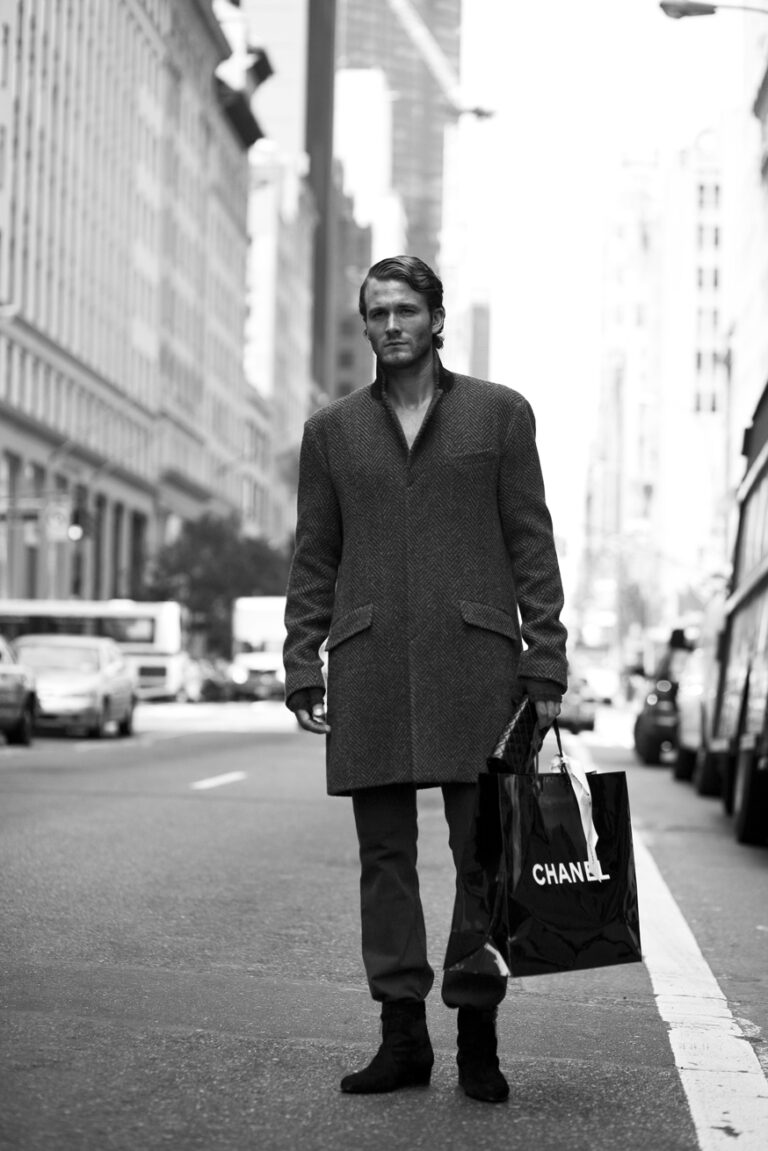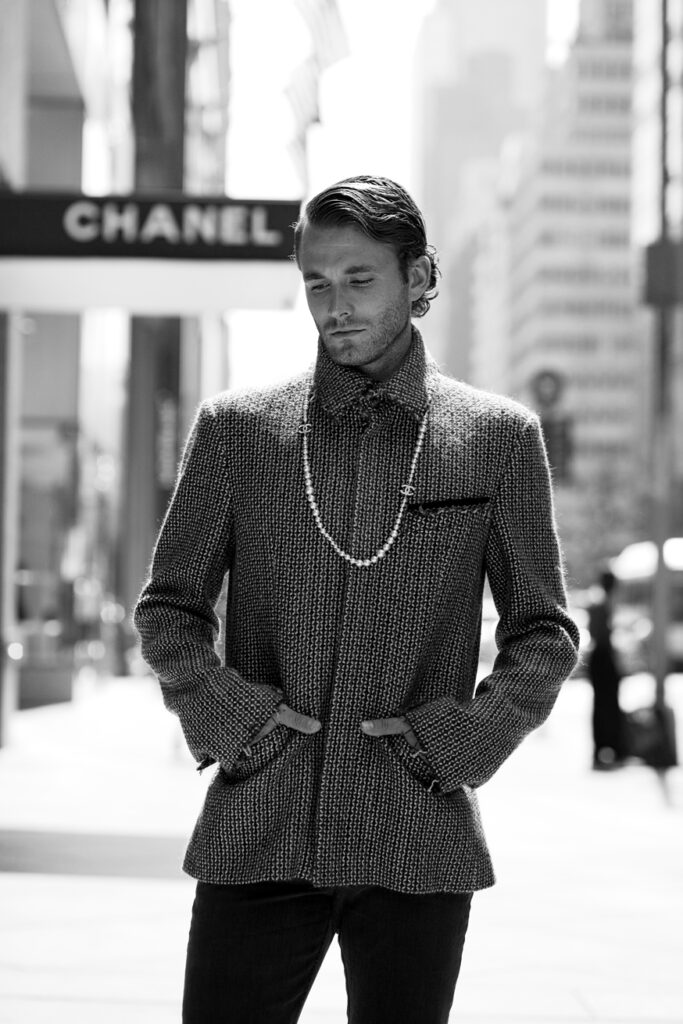Chanel for Men
It’s the most fascinating tale in menswear today: how come the world’s number one fashion label is making men’s clothes, yet barely anyone knows about it?
From Fantastic Man n° 8 — 2008
Text by CHARLIE PORTER
Photography by SCOTT SCHUMAN
Styling by JODIE BARNES


A couple of months ago, I was shopping with a friend in Milan. Walking down Via Sant’Andrea, we came upon Chanel and felt a magnet pull.
It is not a store that I normally go into, because it carries so little for men. Standing outside, we had a discussion: what if this was one of the few branches of Chanel that stocks Mr. Karl Lagerfeld’s much photographed, but rarely seen, menswear for the label? In we went.
From the way the security guard looked at us, it was clear our mission was most likely doomed – there was no need for him to welcome us. On we soldiered, but the pretence of appearing comfortable only increased our awkwardness even more. First we dawdled over the women’s shoes, and luckily I saw a pair that a friend had recently bought – it meant I could pick it up and look at its price with genuine interest.
Then, down a long lit-up corridor, we headed to the clothing. It was between seasons, so the store was stocking what Chanel calls a “satellite” pre-collection, with demi-couture pieces that use the skills of the Parisian specialist ateliers. I knew the menswear pieces definitely existed, because I’d seen the show. Lagerfeld had unveiled them in London, with a big production titled Paris á Londres at the Phillips de Pury auction house. Eight of the 64 looks had been menswear. The men’s clothes must be in store!
We took our time going round the rails, sensing the inevitable but hoping something would turn up. A full circuit of the room completed, and there was none in sight. On the way out, we hid our dejection and still pretended we felt at home, walking out of the store as if we were high-spending regulars.

The hunt for Chanel menswear is a global chase. Few Chanel stores stock it, the most reliable being the Rue Cambon store in Paris, with some items in the flagships in London and New York. The clothing occasionally pops up at an independent retailer, like Jeffrey in New York or Dover Street Market in London. For a brand of the stature of Chanel, this is a remarkably low-key operation.
The menswear is shown each season during its women’s collections. There has never been a Chanel menswear-only show, nor does Chanel present the collection to the men’s industry. Since menswear titles do not attend the women’s shows, it means that one of the biggest fashion houses in the world is producing menswear looks, yet because it is not happening under their nose, most who care about menswear are entirely unaware of the clothes. It’s the most curious stories currently unfolding in menswear.
“We started carrying Chanel for women, and when they showed the men’s collection at a fashion show, we knew that we had a customer that would want Chanel for men,” says Mr. Jeffrey Kalinsky, owner of Jeffrey, the US super-boutique with branches in Atlanta and New York. “The name Chanel is the most desirable in fashion – why wouldn’t the guy who’s interested in fashion want it?”
The first Chanel collection that carried men’s pieces was autumn/winter 2004, when Lagerfeld had the idea of showing a new cut of the Chanel jacket for women on male models, to highlight the severe cut. The male models wore clothing in bigger sizes, but otherwise it was a design intended for women. “The clothes have that clear line, masculine cut which gives women an air of fragile elegance,” Lagerfeld told The Guardian newspaper at the time.
Something obviously clicked, because since then Lagerfeld has shown male clothing in its own right, following Chanel’s theme of the season’s theme. “It changes from season to season,” says Kalinsky. “They offer knitwear, pants, jeans, shirts. There’s certainly not as much to choose from as there is with womenswear, but we still make a selection. We look at the collection and pick the pieces we think will work.” This season, among the pieces stocked at Jeffrey are a grey and navy houndstooth tweed overcoat, a navy wool-felt blazer with silver buttons, and a ribbed crew-neck sweater with zipper details in black, grey and navy. All of the clothes have a distinct air of Chanel, and therefore fashion, about them – none are pieces for those who want to hide under a bushel.
While Jeffrey has been stocking Chanel for men since its debut, Dover Street Market dipped into the menswear as part of a Chanel intervention earlier this year. To coincide with the Paris á Londres collection, each floor was dotted with Chanel installations. The interest in the menswear far exceeded the expectations of the store, with some pieces selling out, like a striped cashmere cardigan at £1390 and a patent-leather belt with a Union Jack buckle. Canvas bags went for £900 a go, while a one-off red and ivory sequinned jacket was bought by Mr. Nigo from Japanese label A Bating Ape (the price of this is undisclosed). What intrigued the store was that while some of the customers were Chanel loyalists who came two blocks west from the store on Bond Street to see what was on offer, many of the purchases were from male Dover Street Market regulars making their first ever Chanel purchase. It proves that when given the chance, there’s a whole market of men eager to buy Chanel menswear.

What makes this tale even more intriguing is that the brand has been selling products to men since the time of Coco Chanel herself. She never made clothes for men, but was greatly inspired by menswear and the ease of their dress. She famously had an affair with the Duke of Westminster from 1925 to 1930, and it was the tweeds of his wardrobe and their trips to Scotland together which inspired the Chanel signature bouclé.
Chanel had sold perfume right from the start of her career, launching her first scent No.5 in 1921. In 1955, the house finally introduced a male fragrance, Pour Monsieur, said to be inspired by the men in Chanel’s life. It is still available today, in the same grey packaging and the same Chanel signature font. What’s remarkable is how easily the visual language of a womenswear house could be adopted for a menswear product – the house style is as masculine as it is feminine.
After Coco Chanel’s death, Pour Monsieur was followed by many more fragrances, including Egoïste with its celebrated Jean-Paul Goude commercial featuring synchronised screaming women opening and slamming shut the shutters of a boulevard building. In 2000 came the launch of the J12 watch, a unisex design that has been a smash seller with men. However, these product categories at Chanel were not originated by Lagerfeld, who concentrates on clothing and accessories. When he decided to show menswear on the catwalk, it was the first time he had ever revealed his vision of what Chanel for men might mean.
It can be tricky for a womenswear house to translate itself into menswear – note how strident Hedi Slimane had to be at Dior to ensure the codes of the house were translated into an appropriately male language when he started Dior Homme from scratch in 2000. Indeed the launch of Dior Homme had an extraordinary effect on Lagerfeld himself. It is well documented that the designer decided to dramatically lose weight just so he could fit into Slimane’s clothes. “I suddenly wanted to dress differently, to wear clothes designed by Hedi Slimane,” Lagerfeld said at the time. “But these fashions, modelled by very, very slim boys – and not men of my age – required me to lose at least eighty pounds.”
Lagerfeld lost the weight and stuck to it, giving him a renewed interest in contemporary menswear. Already a fan of shopping, suddenly his new size allowed him to be a consumer of fashion too – tales circulate of Lagerfeld buying one of everything when Thom Browne first arrived at Colette, and is known to be a repeat customer at Tom Ford.
It makes sense that, now his dialogue with other menswear designers has expanded by wearing more of their clothes, Lagerfeld’s thoughts should move to designing them himself at Chanel. (Lagerfeld has always sold menswear as part of his own Karl Lagerfeld range, which exists as an entirely separate label.) Crucially at Chanel, the menswear appears to have no place whatsoever in a wider business plan: profits aren’t going to rise or fall on the back of the sales of menswear. It’s that rare collection: something created just for the sake of it.

There have been subtle changes since the introduction of menswear at Chanel four years ago. At that first show, the models were young and long-haired, similar to those who were prowling the Dior Homme catwalk. A year later, Lagerfeld debuted a model of a completely different bodyshape at Chanel that has come to set the look for the label’s menswear. Mr. Brad Kroenig, who also features in these images shot for Fantastic Man, is an American whose body is an entire ocean away from the slender European male model shape that had become the norm.
29-year-old Kroenig is originally from St. Louis but now lives in New York and is a constant travelling companion of Lagerfeld. He is also the subject of the designer’s photography: earlier this year, Lagerfeld released a four-volume study called Metamorphoses of an American.
Since Kroenig took to the catwalk, the clothing has become more considered, less severe, and much more in tune with the age of the man who will actually be able to afford Chanel. It was a pair of flared jeans from the recent spring/summer collection that caught Fantastic Man’s eye, and prompted this article. Unlike many pairs of jeans you see, these were cut for the legs of a man, not a boy. They were sold alongside a silk shirt patterned with stars. And yet, few will get to see them, let alone try them on.
This is the dichotomy of the situation. For the moment, Chanel for men is a range almost as exclusive as couture. The scarcity of the clothes only increases one’s desire to find and own them. That sort of allure is rare now that most brands are available in every major city around the world. Maybe Chanel should keep things as they are. But wouldn’t it be a spectacle if Lagerfeld were able to fully develop his ideas on how to drape bouclé on the male body?
Those men who don’t yet own any Chanel, and who have no access to where it is sold, will want the latter to be true. Those men already with a wardrobe full of Chanel will want to keep the brand entirely to themselves. “I think it can go anywhere that Chanel and Karl want it to go,” says Mr. Kalinsky. “For the moment it’s a wonderful opportunity for someone to buy something that isn’t easily found. Is there anything better than Chanel?”
Fashion by Chanel. Model Brad Kroenig. Hair by Leonardo Manetti at Community NYC for ION Studio. Production assistance by Brendan Ore. Thanks to Sam at Ford Models and the staff at the Chanel store.